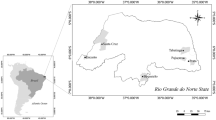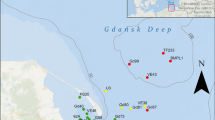Abstract
Adaptive strategies of desmids in two tropical monomictic lakes were studied in relation to morphometric differences. The study aimed at evaluating desmids' strategies during inter-annual succession patterns in two tropical lakes (Dom Helvécio and Carioca) in southeast Brazil. From monthly samples of freshwater algae collected during five consecutive years (2002–2006) from the two lakes, the desmids were classified according to size, life form, and life strategies (competitive, stress tolerant, and ruderal). Our results indicated that Lake Carioca (19º45′20″S, 42º37′12″W), a small, shallow, turbid, and mesotrophic system showed dominance of invasive/opportunistic taxa (C) and R-strategists (Staurastrum species <20 μm), whereas Lake Dom Helvécio (19º45′–19º48′45″S, 42º33′45″W), a large, deep, and clear system was dominated by ruderal (R) species (Closterium aciculare and Pleurotaenium trabecula >50 μm) and tolerant to stress (S) species (Staurastrum and Staurodesmus species >20 μm). A significant number of desmids from the lakes had low MLD (≤20 μm), low volume (<103), and high SV−1 ratio (>1). Consequently, C-strategist species were abundant and formed a group having great adaptive value in the lakes, with higher resilience and capacity to change composition after the turnover period. Stratification stability and atelomixis were the main driving forces to sustain high desmid biomass in these two lakes, despite the greater macrophyte richness and great water column depth at Lake Dom Helvécio and the main factor influencing richness and contribution of complex forms.






Similar content being viewed by others
References
Barbosa, F. A. R. & J. Padisák, 2002. The forgotten lake stratification pattern: atelomixis, and its ecological importance. Verhandlungen internationale Vereinigung für theoretische und angewandte Limnologie 28: 1385–1395.
Barbosa, F. A. R. & J. G. Tundisi, 1980. Primary production of phytoplankton and environmental characteristics of a shallow Quaternary lake at Eastern Brazil. Archiv für Hydrobiology 90: 139–161.
Bezerra-Neto, J. F. & R. M. Pinto-Coelho, 2008. Morphometric study of Lake Dom Helvécio, Parque Estadual do Rio Doce (PERD), Minas Gerais, Brazil: a re-evaluation. Acta Limnologica Brasiliensia 20: 161–167.
Bezerra-Neto, J. F., P. M. Barbosa & F. A. R. Barbosa, 2006. Temporal variation of attenuation of the visible radiation in four lakes of Parque Estadual do Rio Doce (PERD), Minas Gerais, Brasil. Acta Limnologica Brasiliensia 18: 39–46.
Bezerra-Neto, J. F., L. S. Briguenti & R. M. Pinto-Coelho, 2010. A new morphometric study of Carioca Lake, Parque Estadual do Rio Doce (PERD), Minas Gerais State, Brazil. Acta Scientiarum 32: 49–54.
Bland, R. D. & A. J. Brook, 1974. The spatial distribution of desmids in lakes in northern Minnesota, USA. Freshwater Biology 4: 543–556.
Brook, A. J., 1981. The biology of desmids. Blackwell Scientific Publications, Oxford: 275 (Botanical Monographs 16).
Canter, H. M. & J. W. G. Lund, 1966. The periodicity of planktonic desmids in Windermere, England. Verhandlungen internationale Vereinigung für theoretische und angewandte Limnologie 16: 163–172.
Coesel, P. F. M., 1982. Structural characteristics and adaptations of desmid communities. Journal of Ecology 70: 163–177.
Coesel, P. F. M., 1991. Ammonium dependency in Closterium aciculare T. West, a planktonic desmid from alkaline, eutrophic waters. Journal of Plankton Research 13: 913–922.
Coesel, P. F. M., 1996. Biogeography of desmids. Hydrobiologia 336: 41–53.
Coesel, P. F. M. & H. Kooijman-van Blokland, 1991. Seasonality of planktonic desmid species in Lake Maarsseveen (The Netherlands) related to experimentally determined growth rates in a temperature-light gradient. Verhandlungen der internationale Vereinigung für theoretische und angewandte Limnologie 24: 763–767.
Coesel, P. F. M. & H. Kooijman-van Blokland, 1994. Distribution and seasonality of desmids in the Maarsseveen lakes area. Netherlands Journal of Aquatic Ecology 28: 19–24.
Coesel, P. F. M. & K. Wardenaar, 1990. Growth responses of planktonic desmids in a light-temperature gradient. Freshwater Biology 23: 551–560.
Cole, G. A., 1994. Textbook of Limnology. Waveland Press, Illinois: 412 p.
De-Meis, M. R. M. & J. G. Tundisi, 1997. Geomorphological and limnological process as a basis for lake tipology: the middle Rio Doce lake system. In Tundisi, J. G. & Y. Saijo (eds), Limnological studies in the Rio Doce Valley Lakes. Brazilian Academy of Sciences, São Carlos: 25–50.
Godinho, A. L., 1996. Peixes do Parque Estadual do Rio Doce. IEF/UFMG, Belo Horizonte: 48 pp.
Golterman, H. L., R. S. Clymo & M. A. M. Ohmstad, 1978. Methods for physical and chemical analysis of freshwaters. Blackwell Scientific Publications, Oxford: 214 pp.
Grime, J. P., 1979. Plant strategies and vegetation processes. Wiley, New York: 222 pp.
Henry, R. & F. A. R. Barbosa, 1989. Thermal structure, heat content and stability of two lakes in the National Rio Doce Valley Lakes (Minas Gerais, Brazil). Hydrobiologia 181: 189–199.
Hillebrand, H., D. Dürseken, D. Kirschiel, U. Pollingher & T. Zohary, 1999. Biovolume calculation for pelagic and benthic microalgae. Journal of Phycology 35: 403–424.
Hutchinson, G. E., 1957. A treatise on limnology. Wiley, New York: 1015 pp.
Idso, S., 1973. On the concept of lake stability. Limnology and Oceanography 18: 681–683.
Ikusima, I. & J. G. Gentil, 1997. Ecological studies of aquatic macrophytes in four lakes. In: Tundisi, J. G. & Y. Saijo (orgs.), Limnological studies on the Rio Doce Valley lakes, Brazil. Academia Brasileira de Ciências, Rio de Janeiro: 309–326.
Jensen, P., E. Jeppesen, K. Olrik & P. Kristensen, 1994. Impact of nutrients and physical factors on the shift from cyanobacterial to chlorophyte dominance in shallow Danish lakes. Canadian Journal of Fisheries and Aquatic Sciences 51: 1692–1699.
Kosten, S., V. L. M. Huszar, N. Mazzeo, M. Scheffer, L. S. L. Sternberg & E. Jeppesen, 2009. Lake and watershed characteristics rather than climate influence nutrient limitation in shallow lakes. Ecological Applications 19: 1791–1804.
Lorenzen, C. J., 1967. Determination of chlorophyll and pheo-pigments: spectrophotometric equations. Limnology and Oceanography 12: 343–346.
Lund, J. W. G., 1971. The seasonal periodicity of three planktonic desmids in Windermere. Verhandlungen internationale Vereinigung für theoretische und angewandte Limnologie 19: 3–25.
Lund, J. W. G., C. Kipling, & E. D. LeCren, 1958. The invert microscope method of estimating algal numbers and the statistical basis of estimations by counting. Hydrobiologia 11: 143–170.
Mackereth, F. J. H., J. Heron, & J. F. Talling, 1978. Water analysis: some revised methods for limnologists. Titus Wilson & Son Ltd., Kendall: 117 (Freshwater Biological Association Scientific Publication, no. 39).
Margalef, R., 1978. Life-forms of phytoplankton as survival alternatives in an unstable environment. Acta Oceanologica 1: 493–509.
Matsumura-Tundisi, T. & J. G. Tundisi, 1995. Limnology of a warm monomictic lake at rio Doce Forest Park (Lake Dom Helvécio, MG, Eastern Brazil). In: Tundisi, J. G., C. E. M. Bicudo & T. Matsumura-Tundisi (orgs.), Limnology in Brazil. Academia Brasileira de Ciências/Sociedade Brasileira de Limnologia, Rio de Janeiro: 245–256.
McCune, B. & M. J. Mefford, 1997. PC-ORD. Multivariate analysis of ecological data, version 3.0. MjM Software Design, Oregon: 47 pp..
Morales, E. A., F. R. Trainor & C. D. Schlichting, 2002. Evolutionary and ecological implications of plastic responses of algae. Constancea 83: http://ucjeps.berkeley.edu/constancea/83/morales_etal/plasticity.html.
Morris, D. P. & W. M. Lewis, 1988. Phytoplankton nutrient limitation in Colorado mountain lakes. Freshwater Biology 20: 315–327.
Moss, B., 1973. The influence of environmental factors on the distribution of freshwater algae: an experimental study, 2: the role of pH and the carbon dioxide-bicarbonate system. Journal of Ecology 61: 157–177.
Naselli-Flores, L. & R. Barone, 2007. Pluriannual morphological variability of phytoplankton in a highly productive Mediterranean reservoir (Lake Arancio, Southwestern Sicily). Hydrobiologia 578: 87–95.
Naselli-Flores, L., J. Padisák, M. T. Dokulil & I. Chorus, 2003. Equilibrium/steady-state concept in phytoplankton ecology. Hydrobiologia 502: 395–403.
Naselli-Flores, L., J. Padisák & A. Meric, 2007. Shape and size in phytoplankton ecology: do they matter? Hydrobiologia 578: 157–161.
Padisák, J., E. Soróczki-Pintér & Z. Rezner, 2003. Sinking properties of some phytoplankton shapes and the relation of form resistance to morphological diversity of plankton: an experimental study. Hydrobiologia 500: 243–257.
Petrucio, M. M. & F. A. R. Barbosa, 2004. Diel variations of phytoplankton and bacterioplankton production rates in four tropical lakes in the middle Rio Doce basin (Southeastern Brazil). Hydrobiologia 513: 71–76.
Pianka, E. R., 1970. On r and K selection. American Naturalist 104: 592–597.
Reynolds, C. S., 1984. The ecology of freshwater phytoplankton. Cambridge University Press, Cambridge: 365 pp.
Reynolds, C. S., 1987. The response of phytoplankton communities to changing light environments. Schweizerische Zeitschrift für Hydrologie 49: 220–236.
Reynolds, C. S., 1988. Functional morphology and the adaptive strategies of freshwater phytoplankton. In Sandgren, C. D. (ed.), Growth and reproductive strategies of freshwater phytoplankton. Cambridge University Press, Cambridge: 388–433.
Reynolds, C. S., 1997. Vegetation in the pelagic: a model for ecosystem theory. In Kinne, O. (ed.), Excellence in ecology, Vol. 9. Ecology Institute, Oldendorf/Luhe: 371 pp.
Reynolds, C. S., 2006. Ecology of phytoplankton. Cambridge University Press, Cambridge: 535 pp.
Reynolds, R. C., V. Huzsar, C. Kruk, L. Naselli-Flores & S. Melo, 2002. Towards a functional classification of the freshwater phytoplankton. Journal of Plankton Research 24: 417–428.
Shepherd, G. J., 1996. FITOPAC 1: manual de usuário. Universidade Estadual de Campinas, Campinas: 95 pp.
Souza, M. B. G., C. F. A. Barros, F. A. R. Barbosa, É. Hajnal & J. Padisák, 2008. The role of atelomixis in phytoplankton assemblages’ replacement in Dom Helvécio Lake, South-East Brazil. Hidrobiologa 607: 211–224.
Tavares, K. S., 2007. Caracterização limnológica e inventário de diversidade das comunidades de macrófitas em cinco lagos tropicais: composição florística, biomassa e macroinvertebrados associados. Doctoral dissertation, Universidade Federal de São Carlos, São Carlos, Minas Gerais: 132 pp.
Tavera, R. & V. Martínez-Almeida, 2005. Atelomixis as a possible driving force in the phytoplankton composition of Zirahuén, a warm-monomictic tropical lake. Hydrobiologia 533: 199–208.
Utermöhl, H., 1958. Zur Vervolkomnung der quantitative Phytoplankton: Methodik. Mitteilung Internationale Vereinigung für Theoretische und Angewandte Limnologie 9: 1–38.
Wetzel, R. G. & G. Likens, 2000. Limnological analyses, 3rd ed. Springer-Verlag New York Inc., New York: 432 pp.
Woelkerling, W. J. & S. B. Gough, 1976. Wisconsin desmids, 3: desmid community composition and distribution in relation to lake type and water chemistry. Hydrobiologia 51: 3–32.
Acknowledgments
LGB thanks CNPq, Conselho Nacional de Desenvolvimento Científico e Tecnológico, for doctoral scholarship and financial support of the Brazilian Long Term Ecological Research Program (Grant no. 520031/1998–1999); and CEMB also to CNPq, for Research Fellowship (Grant no. 303876/2004-2).
Author information
Authors and Affiliations
Corresponding author
Additional information
Guest editors: Zhengwen Liu, Bo-Ping Han & Ramesh D. Gulati / Conservation, management, and restoration of shallow lake ecosystems facing multiple stressors
Rights and permissions
About this article
Cite this article
Barbosa, L.G., Barbosa, F.A.R. & Bicudo, C.E.M. Adaptive strategies of desmids in two tropical monomictic lakes in southeast Brazil: do morphometric differences promote life strategies selection?. Hydrobiologia 710, 157–171 (2013). https://doi.org/10.1007/s10750-013-1458-0
Received:
Accepted:
Published:
Issue Date:
DOI: https://doi.org/10.1007/s10750-013-1458-0




